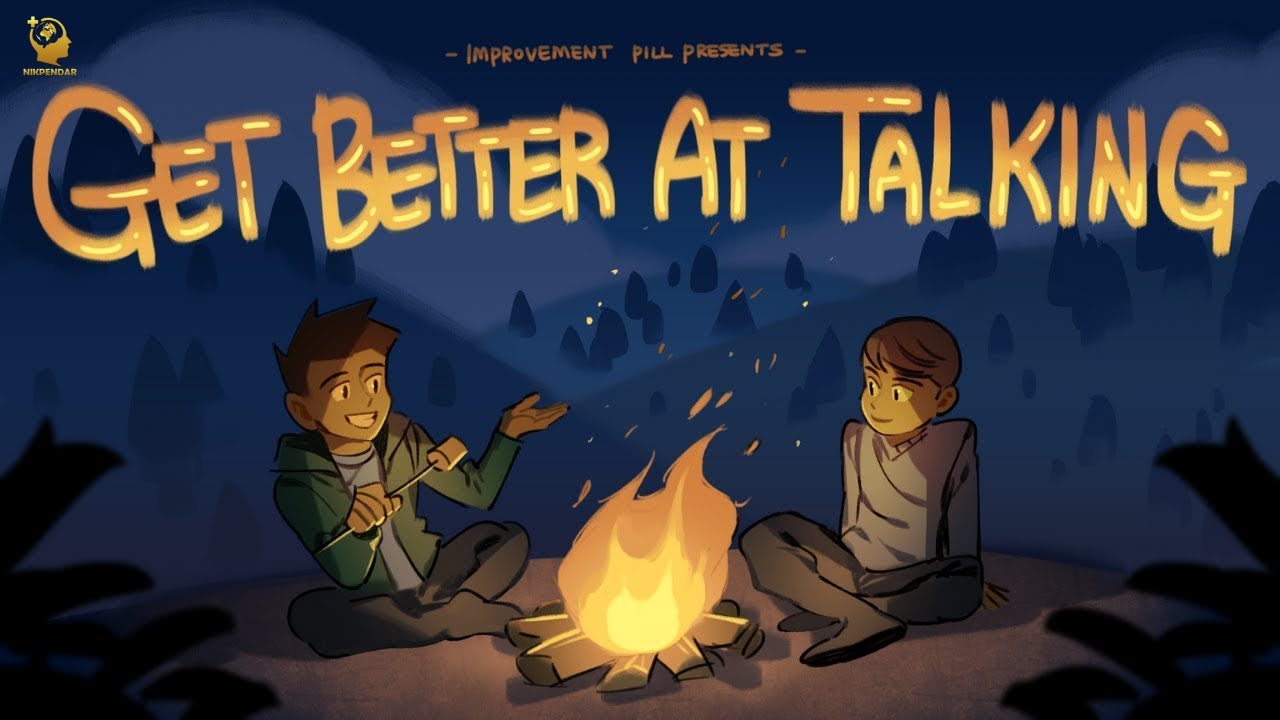
Beginner
Task 1: Why is Talking to People Hard?
- Prompt: The speaker says that many people find it hard to talk in real life today. Why does he say this is happening more often now?
- Instructions: Explain in 2-3 sentences why talking face-to-face can be difficult in modern times.
- Example Phrases to use: “It’s harder because…”, “We spend a lot of time on…”, “Things are missing when you text…”
Task 2: My Experience with Practice
- Prompt: The speaker compares learning to talk in real life to learning to ride a bike. Have you ever learned something new that needed a lot of practice, like riding a bike, playing a sport, or learning a hobby?
- Instructions: Describe what you learned and how practice helped you get better. Use 3-4 sentences.
- Example Phrases to use: “I learned how to…”, “It was hard at first, but…”, “Practice helped me by…”
Intermediate
Task 1: The “Language” of Real-Life Talking
- Prompt: The speaker says that talking to people in real life is like learning a completely different language compared to texting. What are some of the “little components” (like body language, eye contact, etc.) that are missing when you text but are very important in real-life conversations?
- Instructions: List and briefly explain at least three of these components and why they are important for making friends.
- Key Concepts to mention: body language, facial expressions, tonality, speed of talking, proximity, eye contact, patterns and rules.
Task 2: The 100-Interaction Challenge
- Prompt: The speaker suggests something called the “100-interaction challenge” to improve social skills. Describe what this challenge is and how he used it to get better at talking to people.
- Instructions: Explain the main idea of the challenge and give an example of the types of interactions he had. What was the most important benefit he gained from doing it?
- Key Concepts to mention: 100 interactions, month, simple vs. deeper conversations, asking for directions, boosting social skills, practice.
Advanced
Task 1: The Brain’s Role in Social Learning
- Prompt: The speaker argues that humans are a “very social species” and our brains are “extremely good at identifying patterns and rules” for social interactions and language through observation. Discuss this idea. How does the modern reliance on screens (like smartphones and texting) specifically hinder this natural learning process, according to the speaker?
- Instructions: Analyze the biological basis of social learning mentioned. Explain how texting and online communication specifically deprive the brain of the necessary observational data (non-verbal cues). What are the potential long-term implications of this shift for developing strong social skills and fluency in real-life interactions?
- Key Concepts to include: social species, patterns and rules, observation, “socially handicapped” (not born that way), screen time, components of real-life talking (body language, facial expressions, tonality, etc.), fluency, practice.
Task 2: “Jump on and Start Pedaling”: Applying the Bike Analogy to Social Skills
- Prompt: The analogy of learning to ride a bike is central to the speaker’s advice on improving social skills. Explain this analogy in detail. How does “jumping on and starting pedaling” apply to getting better at talking to people, including the likelihood of “falling over” (awkward interactions)?
- Instructions: Fully explain the bike analogy, drawing clear parallels between the physical act of learning to ride and the process of developing social skills. Discuss how consistency and real-world practice lead to learning the “patterns and rules” and developing “finesse” in social interactions. Reflect on how this analogy encourages action over passive learning (e.g., watching videos) for true improvement.
Key Concepts to include: analogy, practice, awkward interactions, falling over, balancing, patterns and rules, finesse, consistency, active learning vs. passive learning.
Beginner
Listening Tasks Based on “The Secret to Getting Better at Talking to People” Transcript
Here are listening tasks for three proficiency levels, based on the provided transcript.
Instructions: Listen carefully to the speaker. Choose the best answer or fill in the blank.
- True or False: The speaker says humans are born “socially handicapped.”
- ( ) True
- ( ) False
- Fill in the Blank: A baby can learn to speak purely through ______________.
- a) reading books
- b) observation
- c) going to school
- Short Answer: What is the “secret” to getting better at talking to people? (Hint: it’s one word)
- Identify Missing Information: When you text, what is one thing that is missing that you need in real-life talking? (Choose one)
- a) Emojis
- b) Body language
- c) Pictures
Intermediate
Instructions: Listen carefully to the speaker. Answer the questions in complete sentences.
- According to the speaker, why are many people’s social skills “not that great” in modern times? What has caused this change?
- The speaker mentions “hundreds of little components” that are important in real-life conversation but are missing in texting. Name at least three of these components.
- What was the “100-interaction challenge” that the speaker took on when he was 18? How many people did he interact with, and in what period of time?
- What kind of simple interactions did the speaker have during the 100-interaction challenge? What was the benefit of these simple interactions?
Advanced
Instructions: Listen carefully to the speaker. Answer the questions in detail, synthesizing information from different parts of the transcript.
- The speaker argues that the human brain is “extremely good at identifying patterns and rules” for social interactions. Explain how this natural ability is being hindered by modern communication habits, providing specific examples from the transcript.
- Analyze the “bike analogy” that the speaker uses at the end of the transcript. Explain what “watching videos” represents in this analogy, what “jumping on and starting pedaling” represents, and what the “falling over” signifies in terms of learning social skills.
- According to the speaker, what is the ultimate result of consistently engaging in real-life interactions, even if they are initially awkward? What qualities or abilities does one gain “over time”?
- Beyond simply getting “more practice,” what is the core reason why interaction is so effective for improving social skills, according to the speaker’s explanation of how the brain learns?
Beginner
Reading Tasks Based on “The Secret to Getting Better at Talking to People” Transcript
Here are reading tasks for three proficiency levels, based on the provided transcript about improving social skills.
Task 1: True or False?
Read the first part of the transcript carefully. Decide if the following statements are True or False.
- Humans are born knowing how to talk to people very well.
- Babies learn to speak by watching and listening to others.
- Spending a lot of time on phones makes it easier to talk in real life.
- Texting has all the same parts as talking in real life.
Task 2: Find the Words
Look at the transcript and find the words that mean:
- A special way of talking or moving your body. (Hint: It starts with ‘l’ and is mentioned often.)
- When you look at someone’s face to see their feelings. (Hint: It starts with ‘f’ and has two words.)
- How high or low your voice is. (Hint: It starts with ‘t’.)
- To get better at something through doing it many times. (Hint: It starts with ‘p’.)
Intermediate
Task 1: Summarize the Main Problem
According to the speaker, what is the main reason why many people’s social skills “aren’t that great” and why they feel “nervous about meeting new people”? Explain this in 3-4 sentences, referring to the role of the brain and modern habits.
Task 2: Explain the “100-Interaction Challenge”
Describe the “100-interaction challenge” the speaker took.
- What was the goal of the challenge?
- How long did it last?
- What kind of interactions did he mostly do?
- What was the result for his social skills?
Task 3: The Bike Analogy
The speaker uses an analogy of learning to ride a bike to explain how to get better at talking to people. Explain this analogy.
- What does “watching videos” about social skills mean in this analogy?
- What does “jumping on and starting pedaling” mean?
- What do “falling over” and “awkward interactions” represent?
Advanced
Task 1: Analyze the Speaker’s Core Argument
The speaker asserts that humans are “socially fluent by design” but often “socially handicapped by modern circumstances.” Analyze this core argument. How does he use the example of a baby learning language to support his claim that we are not “born socially handicapped”? Then, discuss how the rise of screen-based communication has created a “new language” that our brains are not adequately practicing for real-life social interactions.
Task 2: The Neuroscience of Social Observation and Practice
The transcript emphasizes that the human brain is “extremely good at identifying patterns and rules when it comes to social interactions.”
- Explain how real-life interactions provide “hundreds of little components” (e.g., body language, facial expressions, tonality, eye contact) that allow the brain to observe and learn these patterns.
- Conversely, how does communication via “magic little rectangle[s]” (screens) hinder the brain’s ability to observe and process these crucial social cues?
- Discuss the speaker’s implied solution: how does consistent, real-world “practice” help the brain become “fluent” in this “language” of real-life talking, leading to “finesse” and “balance”?
Task 3: Evaluating the “Secret” and its Implications
The speaker presents a simple “secret” to improving social skills: “get more practice.”
- Do you find this “secret” convincing, given the arguments and examples provided? Why or why why not?
- Beyond personal improvement, what broader societal implications might arise if more individuals adopted this approach to improving real-life social fluency?
- Considering the challenge of motivating people to engage in such practice (as hinted by the speaker’s mention of an “accountability group”), what are some potential barriers to implementing this “secret” on a larger scale?
Beginner
Writing Tasks Based on “The Secret to Getting Better at Talking to People” Transcript
Here are writing tasks for three proficiency levels, based on the provided transcript about improving social skills.
Task 1: Why is Talking Different from Texting?
The speaker says that talking to someone in real life is very different from texting. What are some things you see or hear when you talk to someone that you don’t get from a text message? Write 3-4 sentences.
- Keywords to use: body language, facial expressions, eye contact, different, real life
Task 2: My Practice Story
The speaker says that getting better at talking is like learning to ride a bike – you need practice. Think about something new you learned that needed a lot of practice (like a sport, a game, or playing an instrument). Write 3-4 sentences about how practicing helped you get better.
- Keywords to use: practice, learned, better, hard at first, skill
Intermediate
Task 1: The “Language” of Real-Life Socializing
The speaker suggests that real-life talking is like a “completely different language” compared to texting. What are some of the non-verbal cues (like body language, facial expressions, or eye contact) that are essential for successful communication in person, but are absent in text messages? Explain why these cues are important for building connections and making friends.
- Word Count: 80-120 words
- Concepts to include: non-verbal cues, body language, facial expressions, eye contact, tonality, patterns and rules, making friends.
Task 2: The 100-Interaction Challenge
Describe the “100-interaction challenge” proposed by the speaker. How did he use this challenge to improve his own social skills, even with simple interactions like asking for directions? Explain how this kind of consistent practice can lead to significant improvement, even if the interactions are not very “deep” at first.
- Word Count: 100-150 words
- Concepts to include: 100-interaction challenge, practice, social skills, simple interactions, deeper conversations, boost.
Advanced
Task 1: The Brain’s Capacity for Social Learning in the Digital Age
The speaker asserts that the human brain is “extremely good at identifying patterns and rules” for social interactions, a skill we develop through observation from infancy. Analyze how the prevalence of screen-based communication in modern times, according to the speaker, inhibits this natural learning process. Discuss the specific “components” of real-life interaction that are missing from digital communication and explain how their absence affects our ability to become “fluent” in face-to-face social “language.”
- Word Count: 200-250 words
- Key Concepts to address: patterns and rules, observation, social learning, screen time, non-verbal cues (body language, facial expressions, tonality, eye contact), social fluency, impact on brain development.
Task 2: The “Bike Analogy” and Deliberate Practice for Social Skills
The speaker uses the analogy of learning to ride a bike to illustrate the most effective way to improve social skills. Elaborate on this analogy, drawing explicit parallels between the process of learning to balance a bike (including falling and getting back up) and the journey of improving real-life conversational abilities. Discuss why “watching videos” about social skills is insufficient compared to “jumping on and starting pedaling.” How does this analogy emphasize the importance of deliberate practice and resilience in social development?
- Word Count: 250-300 words
Key Concepts to address: bike analogy, direct practice, “falling over” (awkward interactions), balance, patterns and rules, finesse, deliberate practice, resilience, active learning vs. passive learning.





